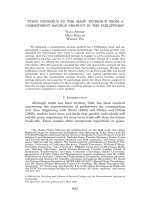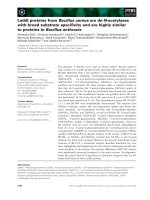Are investors willing to buy non-award-wining funds from awarded fund companies?
Bạn đang xem bản rút gọn của tài liệu. Xem và tải ngay bản đầy đủ của tài liệu tại đây (305.59 KB, 8 trang )
Journal of Applied Finance & Banking, vol. 7, no. 1, 2017, 79-86
ISSN: 1792-6580 (print version), 1792-6599 (online)
Scienpress Ltd, 2017
Are Investors Willing to Buy Non-award-wining Funds
from Awarded Fund Companies?
Ya-Hui Wang1
Abstract
This study takes Franklin Templeton Investments as an example to investigate investors’
purchase intention of non-award-wining funds from an awarded investment company.
We also study the relationships and effects between brand awareness, brand image, brand
trust, perceived quality, and purchase intention of non-award-wining funds. The research
findings show that brand awareness has both significantly direct and indirect effects on
brand trust, and the indirect effects are mainly via brand image and perceived quality.
Besides, both brand image and perceived quality have a significantly direct effect on brand
trust. Brand trust also has a significantly positive effect on purchase intention. However,
both brand image and perceived quality do not have an indirect effect on purchase intention
via brand trust.
JEL classification numbers: G1, M1, M5
Keywords: Brand awareness, Brand image, Perceived quality, Brand trust, Purchase
intention
1 Introduction
Mutual funds represent one of the most popular investment instruments today. Some
institutions hold fund awards to recognize strong performing funds and fund groups that
have shown excellent performance relative to their peers. Many fund companies use
awards they have won as marketing and advertising material, hence raising a few questions:
Does wining an award affect investors’ brand trust? Do investors think awarded fund
companies have a better brand image or a better perceived quality? How about investors’
purchase intention of non-awarded funds from awarded fund companies?
Most related studies on awarded funds target investors’ perceived value or brand preference
for awarded funds (Wang and Tsai, 2014; Wang, 2015). In fact, there is limited research
1
National Chin-Yi University of Technology.
Article Info: Received : September 25, 2016. Revised : October 28, 2016.
Published online : January 5, 2017
80
Ya-Hui Wang
targeting investors’ brand awareness of awarded fund companies (Wang and Lee, 2016), or
investors’ purchase intentions of non-awarded funds from awarded fund companies. This
study looks to fill this gap.
Being a global leader in asset management serving clients for over 65 years in over 150
countries and is famous in Taiwan, Wang and Lee (2016) takes Franklin Templeton
Investments as an example to investigate the relationships between brand awareness, brand
image, brand trust, perceived quality, and purchase intention. Their research findings
show that brand awareness has both significantly direct and indirect effects on brand trust,
and the indirect effects are mainly via brand image and perceived quality. Besides, both
brand image and perceived quality have a significantly direct effect and an indirect effect
(via brand trust) on purchase intention. This study extends Wang and Lee’s (2016)
research to investigate investors’ purchase intention of non-award-wining funds using
questionnaires.
The rest of this paper is organized as follows. Section 2 reviews previous research on
brand awareness, brand image, perceived quality, brand trust, and purchase intention.
Section 3 describes the data and method we employ. Section 4 reports the empirical
results, and section 5 concludes the paper.
2 Literature Review
2.1 Influence of brand awareness on brand image, brand trust and perceived
quality
Consumers are more likely to purchase products with high brand awareness, because a
brand with high awareness does have the effect of increasing consumers’ positive
valuations and lowering consumers’ perceived risks (Shimp & Bearden, 1982; Rao &
Monroe, 1988; Dodds & Grewal, 1991; Aaker, 1991). A brand with high awareness also
promotes brand image, brand trust, and brand loyalty to consumers, which in turn increase
their purchase intention (Aker and Keller, 1990). Thus, we propose the following three
hypotheses.
H1a: Brand awareness has a significantly positive impact on brand image.
H1b: Brand awareness has a significantly positive impact on brand trust.
H1c: Brand awareness has a significantly positive impact on perceived quality.
2.2 Influence of brand image on perceived quality, brand trust and purchase
intention
Brand image is important during the process of consumers’ purchase decision making.
When consumers are evaluating a product before purchasing, brand image is often used as
an extrinsic cue (Zeithaml, 1988; Richardson, Dick and Jain, 1994). A favorable brand
image positively influences consumers’ perceived quality and consumers’ choices about a
particular product (Monroe and Krishnan, 1985; Dodds, Monroe & Grewal, 1991; Keller,
1993; Grewal, Krishnan, Borin & Baker, 1998). It also promotes brand trust to consumers,
which in turn increase their purchase intention (Aker and Keller, 1990). Thus, we propose
the three hypotheses as follows
H2a: Brand image has a significantly positive impact on investors’ perceived quality.
H2b: Brand image has a significantly positive impact on brand trust.
Are Investors Willing to Buy Non-award-wining Funds
H2c:
81
Brand image has a significantly positive impact on investors’ purchase intention.
2.3 Relations between perceived quality, brand trust and purchase intention
Consumers often form their beliefs on the basis of a variety of informational cues, and then
they judge a product’s quality and make their final purchase decision based upon these
beliefs (Olson, 1977). A higher perception of quality has a positive effect on consumers’
brand evaluation about a product (Metcalf, Hess, Danes, and Singh, 2012), it also improves
consumers’ perceived value and then strengthens consumers’ purchase intention (Monroe
and Krishnan, 1985; Zeithaml, 1988; Dodds et al., 1991; Petrick, 2004). Garretson and
Clow (1999), Tsiotsou (2006), and Yee and San (2011) also confirmed the positive impact
of perceived quality on purchase intention.
Brand trust is the willingness of consumers to believe that the brand has the ability to
perform its stated function (Doney and Cannon, 1997) or meet consumers’ expectations
(Chaudhuri & Holbrook, 2001). Both Zboja and Voorhees (2006), Kuan and Bock (2007)
confirmed the positive relationship between brand trust and purchase intention. Thus, we
set up the following hypotheses.
H3a: Perceived quality has a significantly positive impact on brand trust.
H3b: Perceived quality has a significantly positive impact on investors’ purchase
intention.
H4: Brand trust has a significantly positive impact on investors’ purchase intention.
3 Data and Methods
We design the items of the questionnaire for the five dimensions according to the research
framework. The gauging scales are selected from the literature. Brand image is
measured by 5 items take from Park, Jaworski and Maclnnis (1986). Perceived quality is
measured by 3 items by means of Petrick (2002). Brand trust is gauged by 4 items take
from Delgado-Ballester and Munuera-Aleman (2001). Purchase intention is gauged by 3
items take from Zeithaml (1988) and Dodds et al. (1991). All of the items are measured
on Likert’s seven-point scale, ranging from 1 point to 7 points, denoting “strongly disagree”,
“disagree”, “a little disagree”, “neutral”, “a little agree”, “agree”, and “strongly agree”,
respectively.
The questionnaires were administered to investors living in Taiwan from February 1, 2015
to May 31, 2015. A total of 550 responses were distributed, and 500 usable responses
were collected, for an acceptable response rate of 91%. We perform data analyses on
SPSS 20.0 and AMOS 21.0, with the adopted methods including reliability and validity
analysis, correlation analysis, and structural equation modeling (SEM) analysis
4 Analyses and Results
This research conducts confirmatory factor analysis (CFA) to measure reliability and
convergent validity. As presented in Table 1, all the dimensions have a CR value greater
than 0.7, which indicates good internal consistency reliability (Fornell and Larcker, 1981).
Besides, all factor loadings are greater than 0.5, and all Average Variance Extracted (AVE)
82
Ya-Hui Wang
estimates are greater than 0.5 in these five dimensions. This is consistent with the criterion
of convergent validity proposed by Fornell and Larcker (1981) and Hair et al. (2009).
Table 1: Confirmatory factor analysis
Dimension
Brand awareness
Brand image
Perceived quality
Brand trust
Purchase intention
Factor loading
BR1
0.879
BR2
0.936
BR3
0.914
BI1
0.900
BI3
0.886
BI4
0.933
BI5
0.939
BI6
0.934
PQ2
0.864
PQ3
0.897
PQ4
0.940
BT1
0.908
BT3
0.875
BT4
0.846
BT6
0.882
PI2
0.943
PI3
0.937
PI4
0.766
CR
AVE
0.935
0.828
0.964
0.844
0.928
0.812
0.931
0.771
0.916
0.785
Table 2 presents the results of discriminant analysis, with the values on the diagonal being
AVE of our five constructs and values on the non-diagonal are the square of the correlation
between two constructs. According to Fornell and Larcker (1981), we note that the
questionnaire has discriminant validity, because the AVE of each construct is greater than
the square of the correlation between any two constructs. In addition, it also has content
validity, because our scale and item contents are constructed according to the literature
review and do pass the questionnaire pre-test.
Are Investors Willing to Buy Non-award-wining Funds
BA
BI
PQ
BT
PI
Brand
awareness
(BA)
0.828
0.296
0.261
0.364
0.178
83
Table 2: Discriminant analysis
Brand image
Perceived
Brand trust
(BI)
quality
(BT)
(PQ)
0.844
0.570
0.607
0.176
0.812
0.526
0.172
0.771
0.184
Purchase
intention
(PI)
0.785
This research conducts structural equation modeling (SEM) analysis to test the fit of the
factors (dimensions) of brand awareness, brand image, perceived quality, brand trust, and
purchase intention. For a model with good fit, GFI (goodness of fit) should greater than
0.8 (Browne and Cudeck, 1993). AGFI (adjusted goodness of fit) should be greater than
0.8, and CFI (comparative fit index) should be greater than 0.9 (Doll, Xia, Torkzadeh, 1994;
Hair et al., 2009; Gefen et al., 2000). RMSEA (root mean square error of approximation)
should be under 0.08 (Brown and Cudeck, 1993), and the ratio of the chi-square value to
𝜒2
degrees of freedom ( ⁄𝑑𝑓 ) should be no greater than 5 (Wheaton et al., 1977).
The
goodness-of-fit indices of the model are as follows: GFI is 0.892, AGFI is 0.853, CFI is
0.956, RMSEA is 0.083, and
𝜒 2⁄
𝑑𝑓 is 4.475. All these indices are near or within the
acceptable range, meaning the overall model fitness is good.
Figure 1 presents the path analyses from SEM. According to the estimated values of the
standardized parameters of the relationship model in Figure 1, we find that brand awareness
has a significantly positive influence on brand image, brand trust and perceived quality
(H1a, H1b, and H1c are supported). Brand image has a significantly positive effect on
perceived quality and brand trust (H2a and H2b are supported), perceived quality also has
a significantly positive impact on brand trust (H3a is supported). However, both brand
image and perceived quality do not have a significant impact on purchase intention (H2c
and H3b are not supported), but brand trust has a positive influence on purchase intention
(H4 is supported).
84
Ya-Hui Wang
Brand
Image
0.572***
0.125
0.467***
Brand
Awarenes
s
0.234***
Brand Trust
0.301***
Purchase
intention
0.276***
Perceived
Quality
0.119
Figure 1: Path analysis from SEM
5 Conclusion
Mutual funds represent one of the most popular investment instruments today. Some
institutions hold fund awards to recognize strong performing funds and fund groups that
have shown excellent performance relative to their peers. Many fund companies use
awards they have won as marketing and advertising material, hence raising a few questions:
Does wining an award affect investors’ brand trust? Do investors think awarded fund
companies have a better brand image or a better perceived quality? How about investors’
purchase intention of non-awarded funds from awarded fund companies?
This study extends Wang and Lee’s (2016) research to investigate investors’ purchase
intention of non-award-wining funds and the relationships between brand awareness, brand
image, perceived quality, brand trust, and purchase intention. We take Franklin
Templeton Investments as an example, because it has outstanding performance and is
famous in Taiwan. The methods adopted including reliability and validity analysis,
correlation analysis, and structural equation modeling (SEM) analysis.
The research findings show that brand awareness has both significantly direct and indirect
effects on brand trust, and the indirect effects are mainly via brand image and perceived
quality. However, both brand image and perceived quality have not a significantly direct
effect on purchase intention, but brand trust has a direct influence on purchase intention.
Both brand image and perceived quality have an indirect effect on purchase intention via
brand trust. Therefore, we suggest that fund companies should put more efforts to
establish investors’ brand trust when they use awards won as advertising and marketing
material. Once the brand trust is established, investors’ purchase intention will increase
directly.
ACKNOWLEDGEMENTS: We are grateful for the funding of Taiwan’s National ChinYi University of Technology for this study, and the project number is NCUT16-R-MB-006.
Are Investors Willing to Buy Non-award-wining Funds
85
References
[1]
[2]
[3]
[4]
[5]
[6]
[7]
[8]
[9]
[10]
[11]
[12]
[13]
[14]
[15]
[16]
[17]
[18]
[19]
A. Chaudhuri and M. B. Holbrook, The chain of effects from brand trust and brand
affect to brand performance: the role of brand loyalty, Journal of marketing, 65(2),
(2001), 81-93.
A. R. Rao and K. B. Monroe, The moderating effect of prior knowledge on cue
utilization in product evaluations, Journal of consumer research, 15(2), (1988), 253264.
B. Wheaton, B. Muthén, D. F. Alwin and G. Summers, Assessing reliability and
stability in panel models, Social methodology, 8, (1977), 84-136.
C. Fornell and D. F. Larcker, Evaluating structural equation models with unobservable
variables and measurement error, Journal of marketing research, 18, (1981), 39-50.
C. J. Yee and N. C. San, Consumers' perceived quality, perceived value and perceived
risk towards purchase decision on automobile, American journal of economics and
business administration, 3(1), (2011), 47-57.
C. W. Park, B. J. Jaworski and D. J. Maclnnis, Strategic brand concept-image
management, Journal of marketing, 50(4), (1986), 135-145.
D. A. Aaker, Managing brand equity: Capitalizing on the value of a brand name, New
York, 1991.
D. A. Aker and K. L. Keller, Consumer evaluation of brand extensions. Journal of
marketing, 54(1), (1990), 27-42.
D. Gefen, D. W. Straub and M. C. Boudreau, Structural equation modeling and
regression: guideline for research practice, Communications of the association for
information systems, 4(7), (2000), 1-70.
D. Grewal, R. Krishnan, J. Baker and N. Borin, The Effect of store name, brand name
and price discounts on consumers’ evaluations and purchase intentions. Journal of
retailing, 74(3), (1998), 331-352.
E. Delgado-Ballester and J. L. Munuera-Aleman, Brand trust in the context of
consumer loyalty. European Journal of marketing, 35(11/12), (2001), 1238-1258.
H. H. Kuan and G. W. Bock, Trust transference in brick and click retailers: An
investigation of the before-online-visit phase, Information and management, 44(2),
(2007), 175-187.
J. A. Garretson and K. E. Clow, The influence of coupon face value on service quality
expectations, risk perceptions and purchase intentions in the dental industry, Journal
of services marketing, 13(1), (1999), 59-72.
J. C. Olson, Price as an information cue: effects in product evaluation, In A. G.
Woodside, J. N. Sheh and P. D. Bennet (Eds.), Consumer and industrial buying
behavior, 267-286, New York: North Holland Publishing Company, 1977.
J. F. Hair, R. E. Anderson, R. Tatham and W. C. Black, Multivariate data analysis,
Seventh edition, New Jersey: Prentice Hall, 2009.
J. F. Petrick, The roles of quality, value, and satisfaction in predicting cruise
passengers’ behavioral intentions, Journal of travel research, 42(4), (2004), 397-407.
J. F. Petrick and S. J. Backman, An examination of the construct of perceived value
for the prediction of golf travelers’ intentions to revisit, Journal of travel research,
41(1), (2002), 38-45.
J. J. Zboja and C. M. Voorhees, The impact of brand trust and satisfaction on retailer
repurchase intentions, Journal of services marketing, 20(6), (2006), 381-390.
86
Ya-Hui Wang
[20] K. B. Monroe and R. Krishnan, The effect of price on subjective product evaluations,
Perceived quality: How consumers view stores and merchandise, Lexington, MA: DC
Heath, 1985.
[21] K. L. Keller, Conceptualizing, measuring, and managing customer-based brand equity,
Journal of marketing, 57, (1993), 1-22.
[22] L. Metcalf, J. S. Hess, J. E. Danes and J. Singh, A mixed-methods approach for
designing market-driven packaging, Qualitative market research: An international
journal, 15(3), (2012), 268-289.
[23] M. W. Browne, and R. Cudeck, Alternative ways of assessing model fit, In K. A.
Bollen and J. S. Long (Eds.), Testing structural equation models, Newbury Park, CA:
Sage, 1993.
[24] P. M. Doney and J. P. Cannon, An examination of the nature of trust in buyer-seller
relationships, The Journal of marketing, (1997), 61(2), 35-51.
[25] P. S. Richardson, A. S. Dick and A. K. Jain, Extrinsic and extrinsic cue effect on
perceptions of store brand quality, Journal of marketing research, 58(4), (1994), 2836.
[26] R. Tsiotsou, The role of perceived product quality and overall satisfaction on purchase
intentions, International journal of consumer studies, 30(2), (2006), 207-217.
[27] T. A. Shimp and W. Bearden, Warranty and other extrinsic cue effects on consumer
risk perceptions, The journal of consumer research, 9(June), (1982), 38-46.
[28] V. A. Zeithaml, Consumer perceptions of price, quality, and value: a means-end
model and synthesis of evidence, The Journal of marketing, 52(3), (1988), 2-22.
[29] W. B. Dodds, K. B. Monroe and D. Grewal, Effects of price, brand, and store
information on buyers' product evaluations, Journal of marketing research, 28(3),
(1991), 307-319.
[30] W. J. Doll, W. Xia and G. Torkzadeh, A confirmatory factor analysis of the end-user
computing satisfaction instrument, MIS quarterly, 18(4), (1994), 453-461.
[31] Y. H. Wang, Does winning an award affect investors’ brand preference and purchase
intention? International journal of management and marketing research, 8(1), (2015),
57-64.
[32] Y. H. Wang and C. F. Tsai, The relationship between brand image and purchase
intention: Evidence from award winning mutual funds. The international journal of
business and finance research, 8(2), (2014), 27-40.
[33] Y. H Wang and C. C. Lee, Does winning an award matter to brand trust and purchase
intention? – Evidence from Franklin Templeton Investments, Journal of business and
economic policy, 3(1), (2016), 75-81.









